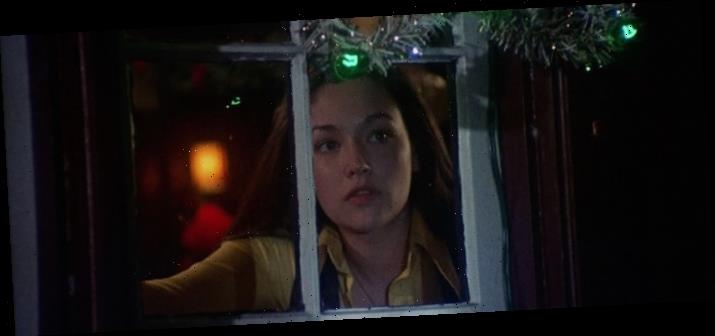When remaking a classic, it often seems like a Catch-22. You veer far away from the original storyline and it gets accused of being a remake in name only. But if you remain too faithful to the source material, then it might get written off as an unoriginal clone. Both remakes of the classic Black Christmas seem to fit into each category, with the newest version seemingly falling under the former and the 2006 version falling into the latter. Regardless of how many re-doings it may get, the original 1974 version still serves a template that has influenced subsequent slasher films. One that captures what feels like a lost art within the genre.
This article contains spoilers for the original Black Christmas.
The main story of Black Christmas is simple. A group of sorority sisters staying on campus over Christmas break are picked off one by one by an escaped maniac named Billy who hides in their attic. In less capable hands, it might’ve coasted on its premise and relied on grotesque kill scenes for shock value along with characters that are cardboard cliches. Yet, director Bob Clark took the path less traveled and offered a more reticent approach, relying on character drama to give the story poignancy while letting the atmosphere generate the creep factor.
There’s hardly any score playing in the background, but sounds like wind blowing and rocking chairs creaking in the attic capture an isolated feeling. The sisters may not be trapped in a hotel in the mountains like The Shining yet it feels like they might as well be there. They even become cut off from one another since nobody hears each other’s screams once Billy starts killing them. He hides in the shadows like a ghost as he claims his victims with the only part of his face shown being his wide eye.
As Billy’s identity remains ambiguous until the very last moment, Black Christmas focuses on setting up the personalities of the protagonists. At its center is Jess Bradford (Olivia Hussey), a shy but kindly student dealing with an unexpected pregnancy. Then there’s Barb (Margot Kidder), a sharp-tongued party girl, Phyllis (Andrea Martin), the no-nonsense brains of the bunch, and Mrs. Mac (Marian Waldman), the ornery house mother.
The dynamic which the women present proves to be the picture’s heart and soul. After one of the sisters dies in the beginning, leading the main group to believe she’s gone missing, Barb is forced to reveal her insecurities beneath her nonchalant wit due to an argument they had beforehand. Also, the banter between Barb and Phyllis allows Phyllis to demonstrate the motherly qualities she possesses. The ones that Mrs. Mac seems to lack despite being their house mother due to her disillusionment over their carefree behavior.
Drinking and casual sex are ways for the sisters to express their adult freedom. In addition to the idea of people being unaware that their attic is inhabited by a psychotic stranger, the horror of the story stems from these women being antagonized for their autonomy. Jess decides to abort her unborn child in order to pursue her life goals. Yet her boyfriend Peter (Keir Dullea) attempts to intimidate her into thinking otherwise for his own self-interest. His toxic masculinity mirrors the threat of independence and solitude which Billy imposes.
Jess being pregnant also prematurely breaks the “final girl” mold that would become consistent throughout the genre. Typically, the female protagonists that survive a slasher film are always virginal and avoid substance abuse. In this case, Jess isn’t a virgin and doesn’t get punished for it, as she gets to survive in the end while maintaining her ability to choose.
As for the 2006 version, it loses the pathos that made the original effective. It works as a standalone B-movie but as a remake, it feels like an evil twin and succumbs to its excess. Within the constraints of its short screen time, it has minimal character development as a result of having more victims this time around and negates tension and atmosphere to focus on being as gross and repulsive as possible.
The story remains the same. A group of sorority sisters getting killed off by a maniac, once again named Billy, who escapes an insane asylum. One key difference is that it reveals Billy’s backstory as opposed to the original where it’s unclear why Billy does what he does. The original thrived on its mystery while the remake’s attempt at showing Billy’s motivations becomes overshadowed by its repugnant violence and plot point involving Billy getting raped by his abusive mother.
Even if the latest remake is an in-name remake only, it still looks to emphasize the importance of women fighting for their individualism against patriarchal predatory males in a more palpable manner. Also, given how it has a female director at the helm, Sophia Takal, who co-wrote the screenplay with April Wolfe, this remake allows women to take full charge of their own narrative.
When it comes to the type of horror films that I love, slasher films are usually at the bottom of the barrel. They have a tendency to be mostly about gore with little soul. The original Black Christmas is a fine example of a slasher film with soul. It’s less about the actual killings and focuses more on those getting killed in order to take viewers on their journey so that we feel devastated when the inevitable happens while simultaneously thriving on the story’s bone-chilling realism.
Source: Read Full Article

